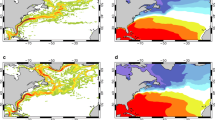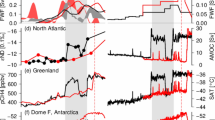Abstract
Using a coupled ocean–atmosphere general circulation model, we investigated the impact of Greenland ice sheet melting on North Atlantic climate variability. The positive-degree day (PDD) method was incorporated into the model to control continental ice melting (PDD run). Models with and without the PDD method produce a realistic pattern of North Atlantic sea surface temperature (SST) variability that fluctuates from decadal to multidecadal periods. However, the interdecadal variability in PDD run is significantly dominated in the longer time scale compared to that in the run without PDD method. The main oscillatory feature in these experiments likely resembles the density-driven oscillatory mode. A reduction in the ocean density over the subpolar Atlantic results in suppression of the Atlantic Meridional Overturning Circulation (AMOC), leading to a cold SST due to a weakening of northward heat transport. The decreased surface evaporation associated with the cold SST further reduces the ocean density and thus, simultaneously acts as a positive feedback mechanism. The southward meridional current associated with the suppressed AMOC causes a positive tendency in the ocean density through density advection, which accounts for the phase transition of this oscillatory mode. The Greenland ice melting process reduces the mean meridional current and meridional density gradient because of additional fresh water flux, which suppress the delayed negative feedback due to meridional density advection. As a result, the oscillation period becomes longer and the transition is more delayed.











Similar content being viewed by others
References
Abdalati W, Steffen K (2001) Greenland ice sheet melt extent: 1979–1999. J Geophys Res 106:33,983–33,988
ACIA (2005) Arctic climate impacts assessment. Cambridge University Press, New York, p 1042
Alvarez-Garcia F, Latif M, Biastoch A (2008) On multidecadal and quasi-decadal North Atlantic variability. J Climate 21:3433–3452
Braithwaite RJ (1995) Positive degree-day factors for ablation on the Greenland ice sheet studied by energy-balance modelling. J Glaciol 41:153–159
Braithwaite R, Olesen OB (1989) Calculation of glacier ablation from air temperature, west Greenland. In: Oerlemans J (ed) Glacier fluctuations and climatic change. Kluwer, Dordrecht, pp 219–233
Bryden HL, Longworth HR, Cunningham SA (2005) Slowing of the Atlantic meridional overturning circulation at 25° N. Nature 438:655–657
Chen JL, Wilson CR, Tapley BD (2006) Satellite gravity measurements confirm accelerated melting of Greenland ice sheet. Science 313:1958–1960
Deser C, Blackmon ML (1995) Surface climate variations over the North Atlantic Ocean during winter: 1900–1989. J Clim 6:1743–1753
Deser C, Phillips AS, Alexander MA (2010) Twentieth century tropical sea surface temperature trends revisited. Geophys Res Lett 37:L10701. doi:10.1029/2010GL043321
Dickson RR, Brown J (1994) The production of North Atlantic deep water: sources, rates and pathways. J Geophys Res 99:12319–12341
Dickson RR, Meincke J, Malmberg S-A, Lee AJ (1988) The “Great Salinity Anomaly” in the northern North Atlantic 1968–1982. Prog Oceanogr 20:103–151
Dickson RR, Lazier J, Meincke J, Rhines P, Swift J (1996) Long-term coordinated changes in the convective activity of the North Atlantic. Prog Oceanogr 38:241–295
Dijkstra HA (2006) Interaction of SST modes in the North Atlantic Ocean. J Phys Oceanogr 36:286–299
Eden C, Jung T (2001) North Atlantic interdecadal variability: oceanic response to the North Atlantic oscillation (1865–1997). J Climate 14:676–691
Frankcombe LM, Dijkstra HA (2010) Internal modes of multidecadal variability in the Arctic Ocean. J Phys Oceanogr 40:2496–2510
Grossmann I, Klotzbach PJ (2009) A review of North Atlantic modes of natural variability and their driving mechanisms. J Geophys Res 114:D24107. doi:10.1029/2009JD012728
Gulev S, Latif M, Keenlyside N (2011) Reconstruction of observationally-based 130-year (1880–2010) time series of surface turbulent fluxes in the North Atlantic: prospects for studying North Atlantic climate variability on decadal to centennial time scales. Proceedings of WCRP OSC 2011 Meeting
Hock R (2003) Temperature index melt modelling in mountain areas. J Hydrol 282:104–115
Holland MM, Bitz CM (2003) Polar amplification of climate change in the Coupled Model Intercomparison Project. Clim Dyn 21:221–232
IPCC (2007) In: Solomon S, Qin D, Manning M, Chen Z, Marquis M, Averyt KB, Tignor M, Miller HL (eds) Climate change 2007: the physical science basis. Contribution of Working Group I to the Fourth Assessment Report of the Intergovernmental Panel on Climate Change. Cambridge University Press, Cambridge
Jacob RL (2007) Low frequency variability in a simulated atmosphere ocean system. Ph. D. Thesis. Univ of Wisconsin Madison. pp. 172
Kushnir Y (1994) Interdecadal variations in North Atlantic sea surface temperature and associated atmospheric conditions. J Clim 7:141–157
Liu Z, Kutzbach J, Wu L (2000) Modeling climate shift of El Nino variability in the Holocene. Geophys Res Lett 27:2265–2268
Lozier MS, Roussenov V, Reed MSC, Williams RG (2010) Opposing decadal changes for the North Atlantic meridional overturning circulation. Nat Geo 3:728–734
Marshall J, Schott F (1999) Open-ocean convection: observations, theory and models. Rev Geophys 37:1–64
Rothrock DA, Percival DB, Wensnahan M (2008) The decline in arctic sea-ice thickness: separating the spatial, annual, and interannual variability in a quarter century of submarine data. J Geophys Res 113:C05003. doi:10.1029/2007JC004252
Schlesinger ME, Ramankutty N (1994) An oscillation in the global climate system of period 65–70 years. Nature 367:723–726
Serreze MC et al (2003) A record minimum arctic sea ice extent and area in 2002. Geophys Res Lett 30. doi:10.1029/2002GL016406
Smith TM et al (2008) Improvements to NOAA’s historical merged land–ocean surface temperature analysis (1880–2006). J Clim 21:2283–2296
Te Raa LA, Dijkstra HA (2002) Instability of the thermohaline ocean circulation on interdecadal timescales. J Phys Oceanogr 32:138–160
Ting M, Kushnir Y, Seager R, Li C (2009) Forced and internal twentieth-century SST trends in the North Atlantic. J Climate 22:1469–1481
Wang C, Dong S, Munoz E (2010) Seawater density variations in the North Atlantic and the Atlantic meridional overturning circulation. Clim Dyn 34:953–968
Wohlleben TM, Weaver AJ (1995) Interdecadal climate variability in the subpolar North Atlantic. Clim Dyn 11:459–467
Wu L, Liu Z (2002) Is tropical Atlantic variability driven by the North Atlantic oscillation? Geophys Res Lett 29. doi:10.1029/2002GL014939
Wu L, Liu Z (2005) North Atlantic decadal variability: air–sea coupling, oceanic memory, and potential northern hemisphere resonance. J Clim 18:331–349
Wu L, Liu Z, Gallimore R, Jacob R, Lee D, Zhong Y (2003) Pacific decadal variability: the tropical Pacific mode and the North Pacific mode. J Climate 16:1101–1120
Acknowledgments
The authors thank Profs. A. Timmermann and H. Yang for their valuable comments. This work was supported by SBS foundation and the Polar Academic Program (PAP), KOPRI.
Author information
Authors and Affiliations
Corresponding author
Rights and permissions
About this article
Cite this article
An, SI., Kim, H. & Kim, BM. Impact of freshwater discharge from the Greenland ice sheet on North Atlantic climate variability. Theor Appl Climatol 112, 29–43 (2013). https://doi.org/10.1007/s00704-012-0699-6
Received:
Accepted:
Published:
Issue Date:
DOI: https://doi.org/10.1007/s00704-012-0699-6




